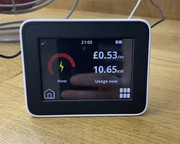
Smart meter
Smart meter
12x 340W JA Solar panels (4.08kWp)
3x 380W JA Solar panels (1.14kWp)
6x 2.4kWh Pylontech batteries (14.4kWh)
LuxPower inverter/charger
(Artist formally known as ******, well it should be obvious enough to those for whom such things are important.)
3x 380W JA Solar panels (1.14kWp)
6x 2.4kWh Pylontech batteries (14.4kWh)
LuxPower inverter/charger
(Artist formally known as ******, well it should be obvious enough to those for whom such things are important.)
Re: Smart meter
They do indeed. Also they understand the daily charge. It puzzled me at first why the £pp usage was so high when I first glanced at the IHD at breakfast time.
However, the gas usage is in kWh whereas the billing is in cubic metres multiplied by a calorific factor (~39) and other factors. So it is hard to connect the daily consumption in cu M as supplied on the bill and downloads with the IHD. Especially as the average conversion factor won't be known until the end of the billing period.
Also the IHD is based on calendar months instead of the mid-month billing cycle. So the monthly cost on the IHD never equals the bill or the payment. Octopus are happy to let me pay on the actual usage rather than expected annual usage divided by 12 (plus fudge factor). With a BEV it is hard to predict annual usage and there can be a lot of month to month variability especially in the summer.
Simple solution is to multiply cu M by 11 to get kWh. Good enough for most of us.


Also the IHD is based on calendar months instead of the mid-month billing cycle. So the monthly cost never equals the bill or the payment. Octopus are happy to let me pay on the actual usage rather than expected annual usage divided by 12 (plus fudge factor). With a BEV it is hard to predict annual usage and there can be a lot of month to month variability especially in the summer.
However, the gas usage is in kWh whereas the billing is in cubic metres multiplied by a calorific factor (~39) and other factors. So it is hard to connect the daily consumption in cu M as supplied on the bill and downloads with the IHD. Especially as the average conversion factor won't be known until the end of the billing period.
Also the IHD is based on calendar months instead of the mid-month billing cycle. So the monthly cost on the IHD never equals the bill or the payment. Octopus are happy to let me pay on the actual usage rather than expected annual usage divided by 12 (plus fudge factor). With a BEV it is hard to predict annual usage and there can be a lot of month to month variability especially in the summer.
Simple solution is to multiply cu M by 11 to get kWh. Good enough for most of us.
Also the IHD is based on calendar months instead of the mid-month billing cycle. So the monthly cost never equals the bill or the payment. Octopus are happy to let me pay on the actual usage rather than expected annual usage divided by 12 (plus fudge factor). With a BEV it is hard to predict annual usage and there can be a lot of month to month variability especially in the summer.